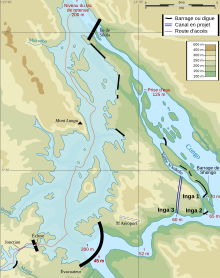Grand Inga Dam
| Grand Inga Dam | |
|---|---|

Location of the Grand Inga Dam (lower centre), along with other Inga Dams.
|
|
|
Location of the Grand Inga in the Democratic Republic of the Congo
|
|
| Country | Democratic Republic of the Congo |
| Location | Inga |
| Coordinates | 05°32′45″S 13°33′25″E / 5.54583°S 13.55694°ECoordinates: 05°32′45″S 13°33′25″E / 5.54583°S 13.55694°E |
| Status | Proposed |
| Opening date | 2020-2025 (expected) |
| Construction cost | US$80 billion |
| Dam and spillways | |
| Impounds | Congo River |
| Height | 205 m (673 ft) |
| Power station | |
| Turbines | 52 × 750 MW (1,010,000 hp) |
| Installed capacity | 39,000 MW (52,000,000 hp) (proposed) |
The Grand Inga Dam is a proposed hydroelectric dam on the Congo River at Inga Falls in the Democratic Republic of the Congo.
The proposed dam is the fourth and largest of the Inga dams, 8 kilometres (5.0 mi) from Inga-I, 7.3 kilometres (4.5 mi) from Inga-II, and 6.5 kilometres (4.0 mi) from the proposed Inga-III.
The dam has an expected generating capacity of 39,000 MW (52,000,000 hp), with 52 turbines each with a capacity of 750 MW (1,010,000 hp). This is a significantly larger capacity than the Three Gorges Dam, which is currently known as the largest energy-generating body ever built.
Inga Falls on the Congo River is a group of rapids (or cataracts) in the latter portion of the Livingstone Falls. The Congo falls ~96 metres (315 ft) within this set of cataracts. The mean annual flow rate of the Congo River at Inga Falls is ~42,000 cubic metres per second (1,500,000 cu ft/s). Given this flow rate and the 96 metre fall it is easy to calculate that the Inga Falls alone has a potential to generate ~39.6 gigawatts (53,100,000 hp) of mechanical energy and nearly as much electrical energy.
Inga Falls is currently the site of two large hydro power plants and is being considered for a much larger hydro power generating station known as Grand Inga. The Grand Inga project, if completed, would be the largest hydro-electric power generating facility on Earth. The current project scope calls for the use of a flow rate ~26,400 cubic metres per second at a net head of ~150 metres; this is equivalent to a generating capacity of ~38.9 GW. This hydro-electric generator would be more than double the current world record holder, which is the Three Gorges facility on the Yangtze River in China.
...
Wikipedia

